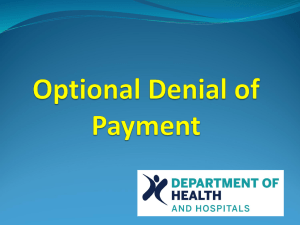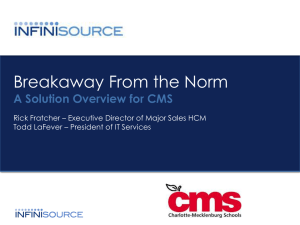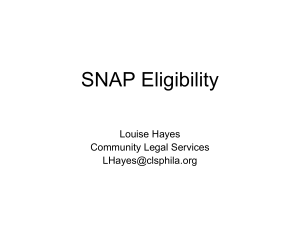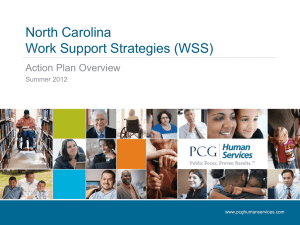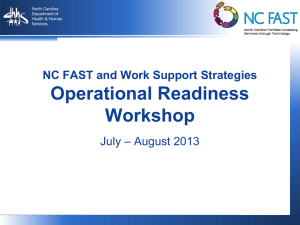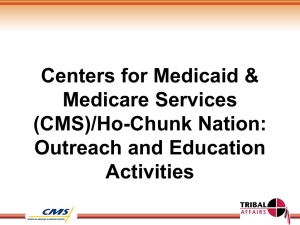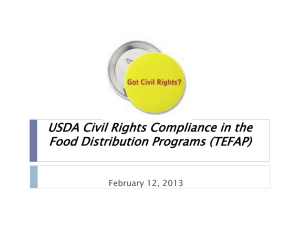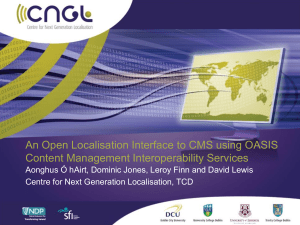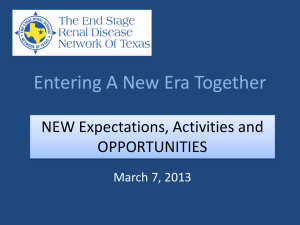ACAApplicationsSession - American Public Human Services
advertisement
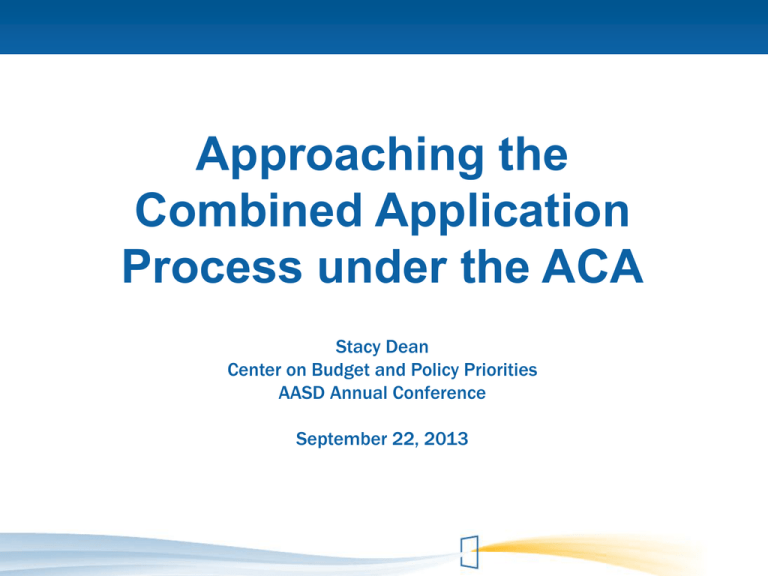
Approaching the Combined Application Process under the ACA Stacy Dean Center on Budget and Policy Priorities AASD Annual Conference September 22, 2013 Our Plan for Today 1. Overview of Multi-Benefit Application Landscape Today 2. Overview of Key CMS and FNS Guidance on Multi-Benefit Applications 3. Presentations from Alaska, California and New Mexico 4. Q & A States with Joint SNAP/Medicaid Applications (pre ACA) 19 States Have Multi-Benefit Applications Approved for Day 1 4 Key CMS Requirements • Must have a single, streamlined health-only application as well • Must be a pathway to all insurance affordability programs – There are some new questions that must be included – Some questions will likely have to be revised • Questions for non-health programs can’t be a barrier to a MAGI determination • Approval process 5 Data Element Needs for Health Applications MAC Collaboratives: Federal/state partnership to support high-performing state health insurance programs. Established by the Centers for Medicare &Medicaid Services and coordinated by MathematicaPolicy Research, the Center for Health Care Strategies, and ManattHealth Solutions. Visit http://www.Medicaid.gov. 6 Household Income Ex: Required Change to an Old Question (Income) Need to estimate Next Year’s Income Idaho's Integrated Application 7 Approval Process • State plan amendment process – CMS is offering TA – Conditional approval option for 2014 • States must submit – Analysis document identifying key differences between alternative and model applications – A copy of paper applications – For online: flow chart, screen shots and/or questionnaire (CMS request demo) 8 Use of Alternative Applications • Information about States that are approved will be made public with the “State’s Profile.” • So far it appears that most states will have at least one alternative application and very few Medicaid agencies will use the HHS applications. 9 Resources • CMS resources – Guidance:http://www.medicaid.gov/AffordableCareAct/Provisions/Downloads/Alternative -App-Guidance-061813-508-comp.pdf – Tools for multi-benefit applications: http://www.medicaid.gov/State-ResourceCenter/MAC-Learning-Collaboratives/Learning-Collaborative-State-Toolbox/State-ToolboxExpanding-Coverage.html • Other resources: – Coordinating Human Services Programs with Health Reform Implementation: A Toolkit for State Agencies http://www.cbpp.org/files/6-6-12health.pdf – Communicating in Plain Language, by Nicole Donnelly, Penny Lane, and Joan Winchester at the Maximus Center for Health Literacy, February 2012, http://files.www.enrollamerica.org/best-practices-institute/publications-andresources/2012/Communicating_with_Plain_Language.pdf – Online Services for Key Low-Income Benefit Programs: What States Provide Online with Respect to SNAP, TANF, Child Care Assistance, Medicaid, CHIP, and General Assistance, Center on Budget and Policy Priorities, http://www.cbpp.org/cms/index.cfm?fa=view&id=1414 10 SNAP Application Requirements Remain • Right to file an application without delay – Ability to submit with just “name, address, signature” – Minimal pre-registration process • Location of expedited screening questions • Recent FNS Guidance on online applications: – SNAP Applications and the ACA http://www.fns.usda.gov/sites/default/files/SNAP080213.pdf – Online Application and Review Results http://www.fns.usda.gov/snap/rules/Memo/2011/121710 .pdf 11 SNAP Applications and the ACA • States must notify FNS when existing applications are modified or launched. • FNS prepared an Online Application Checklist for states to use to review their applications. • FNS regions will review all applications for compliance by September 2014. 12 FNS Online Checklist 13 Goals for a New Multi-Benefit Application • Apply for all multiple services with one application • Ensure those who are not Medicaid eligible could be easily determined for an APTC • Integrate the application with automated eligibility system and processes • Meet compliance standards for federal programs 14 Issues for SNAP-Health Applications Limited guidance on multi-benefit application rules or approval processes • Examples? • What’s the turnaround? • CMS/FNS coordination? Possible policy conflicts • “My account” registration requirements • Accepting incomplete applications • Authorized Rep rules Length and complexity may increase Transition issues vs. long term • Model health applications are long and complex • SNAP can save questions for the interview • Tight time frames may necessitate creative short term solutions • Over the long run, applications will tie into new integrated eligibility systems 15 Putting Together the Pieces: Keys to a Combined Streamlined Application AASD Conference September 22-25, 2013 Horizontal Integration – – – The ACA requires the federal Secretary of HHS to develop health information technology (HIT) interoperable and secure standards and protocols that facilitate enrollment of individuals in federal and state health AND human services programs. The law specifically requires these standards to allow for the “ability to expand the enrollment system to integrate new programs, rules, and functionalities, to operate at increased volume, and to apply streamlined verification and eligibility processes to other federal and state programs, as appropriate.” What this means in California– By January 1, 2014, our eligibility enrollment systems and policies must be aligned with Covered California (CC) so that persons applying for health coverage (private, subsidized or Medi-Cal) through CC or through County Welfare Departments can enroll in health coverage, and our programs in a streamlined process. Impact to SNAP/TANF – Applications, policies, and procedures must be redesigned to facilitate enrollment for all programs. Setting Goals and Facing Challenges Integrating program questions to avoid duplication and a LONG application Sequencing questions in a logical order Making it clear to clients what questions to answer for what programs Ensuring only one signature is required How to handle MAGI and Non MAGI questions ~~~~~~~~~~~~ Development Process We started with our SNAP app as the building blocks as it is key ~~~~~~~~~~~~ We worked with stakeholders to develop SNAP app based on review of applications from every other state. Finalized in April. “Imitation is the sincerest form of flattery” Single Streamlined Application CMS released the Single Streamlined Application (SSApp) in May 2013 – our computer systems needed data elements immediately to begin programming. A few people (1 TANF, 2 SNAP) worked feverishly to put together a draft that added required elements from TANF and SSApp into the SNAP application. Once draft was assembled in June, walked through with CMS, FNS, counties, health exchange and programming staff. Combined Streamlined Application We quickly incorporated edits and provided feedback to all. Highly encourage early involvement with CMS. The application was finalized in July and work began on translations and printing. Paper applications are available in October. Final application language is now being programmed into systems to be available in January for online applications. Successes We developed grids for listing of adults and child applicants that incorporate the key questions for program so there are not repetitive pages to complete for each person. It makes it a lot easier visually to see household composition. This approach also lent itself to a more logical flow of questions, e.g., first income, then deductions for every member of the household. Using symbols, we made is visually very clear for those using paper applications which questions they need to answer depending on the program. We achieved a one signature required form that integrated many other forms into one document. Successes Successes Next Steps Despite our best efforts to “streamline” a multi-program application is longer than one would hope. While OK for initial application, one next step is develop a much leaner application for renewals. Additionally, since required to move very quickly to have in place, there will be future revisions as people work with it. Other stakeholders, like advocates, were assured they would have opportunities to tweak in the future. There was less resistance as they had all been involved in the work to develop the SNAP app. Making it Work Developing A Combined Application for Alaska Goals Continue to use one application for all programs. Complete revisions by October 1. Continue to meet federal requirements for all programs. Make application less burdensome for the client. Gather as much information as possible so we don’t have to pend or send supplemental forms. Include all post eligibility forms (absent parent form, employer statement, voter registration) Timeline April Established Work Team May Initial Revision June • Edited for Content • Initial CMS Review July Revised with CMS Comments August • FNS Review • Dept of Law Review • Field review • Updated application • Formatting September •Final Policy Review •CMS Review •Final Formatting •Printer Process Surveyed staff and applicants about what they liked and didn’t like about our current application Paper application designed by new policy staff Reviewed federal regulation – which suggestions from survey could we do? Once we had the FFM application, used that format/questions to design our paper application Online application designed by Deloitte with input from agency staff. CMS reviewed both online and paper application. reviewed paper application. FNS Successes Modernization Online Application Communicate with applicants and recipients via email CMS approved our application more quickly than we expected. Questions for other Public Assistance programs were not changed. There’s more room for people to provide information because each individual has their own page. Less chance the case will be pended because have more information. Income Information Appendices Challenges Online Application Last minute review of online application by CMS. Will be for ACA related Medicaid only until 7/15. Will not auto populate new system. Paper Application Coordinating edits to paper application long distance. Perceived as being too long but it went from 24 pages to 27. Staffing struggles Final regulations and feedback from CMS slow. Different visions between federal programs and internally. Not allowed to ask questions that will streamline the process (such as absent parent information). FFM application can’t be used to protect start date for other programs. Additional Questions Required by FNS Next Steps Work towards designing an online application for all programs. Review applications from other states to get ideas for improvement. Get feedback from the field and applicants as they use the applications. Change and change again Bringing It all Together New Mexico’s Streamlined Application for Assistance Utilize one application to for all programs. Ensure application is ready on October 1, 2013. Ensure compliance with all Federal Programs (CMS, FNS and Voter Registration). Ensure compliance with current Legal Settlement Agreements. Ensure proper sequencing of questions meeting all of the federal mandates for “on or near the front of the application.” Make it clear to applicants which questions to answer for each program. Internal Stakeholders were brought together in September 2012. The included representation from the following: Office of the Secretary (OOS) Medical Assistance Division (MAD) Income Support Division (ISD) Information Technology Division (ITD) MAD staff incorporated the ACA requirements (known at the time) into the existing combined application. ISD staff reviewed to ensure that application met the Federal requirements. During review by Office of General Counsel, met with our IT contractor Deloitte to map the Streamlined Application with the Online Application on the new Your Eligibility System New Mexico (YES-NM) and ASPEN Utilized FFM application to re-format and add questions to the design. CMS reviewed paper application first. They are currently reviewing the Online Application. Received public comment from our Settlement Agreement Plaintiff’s. Modernization Online Application (YES-NM) New Eligibility System (ASPEN) Updated existing application for other Public Assistance programs that were not previously included. CMS comments were not extensive mostly suggestions or clarifications. Online Application Last minute review of online application by CMS – Sent on 9/19. Mapping of the paper application with YES-NM and ASPEN ensuring the capture of the data needed by the Marketplace. Paper Application Coordinating edits from many all stakeholders. Perceived as being too long but it went from 12 to 19 pages. Late receipt of Final regulations. Ensuring clarification of different requirements between federal programs when gathering information such as income. FFM application can’t be used to protect start date for other programs. The Finished Product Income Information Continue to refine the online application to include all of the data required by the FFM. Review applications from other states to get ideas for improvement. Vida Tapia-Sanchez Acting ISD Deputy Director of Field Operations 505-827-1300 Vida.Tapia-Sanchez@state.nm.us.
